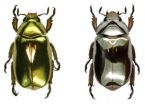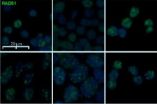(Press-News.org) WASHINGTON, April 25—Costa Rica was once regarded as the poorest of all the colonies of the Spanish Empire, sadly deficient in the silver and gold so coveted by conquistadors. As it turns out, all of the glittering gold and silver those explorers could have ever wanted was there all along, in the country's tropical rainforests—but in the form of two gloriously lustrous species of beetle.
Today, the brilliant gold- (Chrysina aurigans) and silver-colored (Chrysina limbata) beetles have given optics researchers new insights into the way biology can recreate the appearance of some of nature's most precious metals, which in turn may allow researchers to produce new materials based on the natural properties found in the beetles' coloring.
A team of researchers at the University of Costa Rica has found that the beetles' metallic appearance is created by the unique structural arrangements of many dozens of layers of exo-skeletal chitin in the elytron, a hardened forewing that protects the delicate hindwings that are folded underneath. A paper about the discovery appears in the first issue of the Optical Society's (OSA) newest open access journal, Optical Materials Express, which launched this month.
The beetles were captured in the University of Costa Rica's Alberto Brenes Mesén Biological Reserve, a tropical rainforest environment. "The metallic appearance of these beetles may allow them to be unnoticed, something that helps them against potential predators," says physicist and study leader William E. Vargas. The surface of their elytra "reflects light in a way that they look as bright spots seen from any direction," he explains. "In a tropical rainforest, there are many drops of water suspended from the leaves of trees at ground level, along with wet leaves, and these drops and wet leaves redirect light by refraction and reflection respectively, in different directions. Thus, metallic beetles manage to blend with the environment."
To interpret the cause of this metallic look, Vargas and his team assumed that a sequence of layers of chitin appears through the cuticle, with successive layers having slightly different refractive indices.. In these beetles, the cuticle, which is just 10 millionths of a meter deep, has some 70 separate layers of chitin—a nitrogen-containing complex sugar that creates the hard outer skeletons of insects, crabs, shrimps, and lobsters. The chitin layers become progressively thinner with depth, forming a so-called "chirped" structure.
"Because the layers have different refractive indices," Vargas says, "light propagates through them at different speeds. The light is refracted through—and reflected by—each interface giving, in particular, phase differences in the emerging reflected rays. For several wavelengths in the visible range, there are many reflected rays whose phase differences allow for constructive interference. This leads to the metallic appearance of the beetles."
This is similar to the way in which a prism breaks white light into the colors of the rainbow by refraction, but in the case of these beetles, different wavelengths, or colors of light are reflected back more strongly by different layers of chitin. This creates the initial palette of colors that enable the beetles to produce their distinctive hues. The mystery the researchers still needed to understand in more detail, however, was how the beetles could so perfectly create the structure causing the brilliant metallic tones of silver and gold.
Using a device they specially designed to measure the reflection of light when it strikes the curved surface of the beetles' elytra, Vargas and his colleagues found that as light strikes the interface between each successive layer (the first interface being the boundary between the outside air and the top chitin layer), some of its energy is reflected and some is transmitted down to the next interface.
"This happens through the complete sequence of interfaces," Vargas says.
Because a portion of the light is reflected, it combines with light of the exact same wavelength as it passes back through layer upon layer of chitin, becoming brighter and more intense. Ocean waves can exhibit the same behavior, combining to produce rare but powerful rogue waves. In the case of the beetles, this "perfect storm" of light amplification produces not only the same colors but also the striking sheen and glimmer that we normally associate with fine jewelry.
In the two beetle species, interference patterns are produced by slightly different wavelengths of light, thus producing either silver or gold colors. "For the golden-like beetle, the constructive interference is found for wavelengths larger than 515 nm, the red part of the visible wavelength range," Vargas says, "while for the silver-like beetle it happens for wavelengths larger than 400 nm—that is, for the entire visible wavelength range."
"The detailed understanding of the mechanism used by the beetles to produce this metallic appearance opens the possibility to replicate the structure used to achieve it," Vargas says, "and thus produce materials that, for example, might look like gold or silver but are actually synthesized from organic media."
This potentially could lead to new products or consumer electronics that can perfectly mimic the appearance of precious metals. Other products could be developed for architectural applications that require coatings with a metallic appearance. Vargas notes that in the solar industry, for example, chirped multilayer reflectors could be used as back layers supporting the active or light-absorbing medium, to improve the absorption of the back-reflected light.
INFORMATION:
The article, "Visible light reflection spectra from cuticle layered materials," by Cristian Campos-Fernández, Daniel E. Azofeifa, Marcela Hernández-Jiménez, Adams Ruiz-Ruiz and William E. Vargas appears in the journal Optical Materials Express. It can be accessed at: http://www.opticsinfobase.org/ome/abstract.cfm?URI=ome-1-1-85.
EDITOR'S NOTE: High-resolution images of the beetles are available upon request. Please contact Angela Stark, astark@osa.org.
About Optical Materials Express
Optical Materials Express (OMEx) is OSA's newest peer-reviewed, open-access journal focusing on the synthesis, processing and characterization of materials for applications in optics and photonics. OMEx, which launched in April 2011, primarily emphasizes advances in novel optical materials, their properties, modeling, synthesis and fabrication techniques; how such materials contribute to novel optical behavior; and how they enable new or improved optical devices. For more information, visit www.OpticsInfoBase.org/OMEx.
About OSA
Uniting more than 106,000 professionals from 134 countries, the Optical Society (OSA) brings together the global optics community through its programs and initiatives. Since 1916 OSA has worked to advance the common interests of the field, providing educational resources to the scientists, engineers and business leaders who work in the field by promoting the science of light and the advanced technologies made possible by optics and photonics. OSA publications, events, technical groups and programs foster optics knowledge and scientific collaboration among all those with an interest in optics and photonics. For more information, visit www.osa.org.
Beetle bling: Researchers discover optical secrets of 'metallic' beetles
Article published in new Optical Materials Express journal unveils secrets of how biology recreates look and luster of gold and silver
2011-04-26
ELSE PRESS RELEASES FROM THIS DATE:
Laying bare the not-so-sweet tale of a sugar and its role in the spread of cancer
2011-04-26
BETHESDA, Md., April 25, 2011 – Cancer has a mighty big bag of tricks that it uses to evade the body's natural defense mechanisms and proliferate. Among those tricks is one that allows tumor cells to turn the intricate and extensive system of lymphatic vessels into something of a highway to metastasis. Yet research unveiled this week may aid in the development of therapeutics that will put the brakes on such cancer spread, and the researchers who completed the study say the findings may extend to other lymphatic disorders.
In the latest issue of the Journal of Biological ...
Researchers identify novel pathophysiologic mechanism responsible for autoimmunity
2011-04-26
(Boston) – Researchers from Boston University School of Medicine (BUSM) have discovered that human proteins with an affinity for Dermatan Sulfate (DS) have the propensity to become autoantigens. In a companion article, the researchers also found that DS physically interacts with dead cells and that the resulting DS–autoantigen complexes drive autoreactive B-1a cell responses and autoantibody production both in-vitro and in mouse models. These findings, which appear in two back-to-back papers in the May issue of the American Journal of Pathology, provide a promising tool ...
In cap and trade fight, environmentalists had spending edge over opponents, new report finds
2011-04-26
New research challenges the commonly-held view that cap and trade legislation failed because of the spending advantages of opponents and false balance in news coverage. The report, "Climate Shift: Clear Vision for the Next Decade of Public Debate," was released today by American University Professor Matthew Nisbet.
"There is a tendency among environmentalists and scientists to blame political inaction on the spending advantage enjoyed by conservatives and on false balance in media coverage," says Nisbet. "However, this analysis shows that the effort by environmentalists ...
Collective conservation efforts boosted rhino population in Nepal
2011-04-26
Chitwan, Nepal – After three rigorous weeks of conducting the National Rhino Census in Nepal, new data on the population of greater one-horned rhinoceros (Rhinoceros unicornis) was formally released today.
According to the census, there are 534 rhinos in Nepal, marking an increase of 99 rhinos from the 435 recorded in the last census in 2008; 503 were recorded in Chitwan National Park (an increase of 95 from 2008 data), 24 in Bardia National Park (an increase of 2 from 2008 data) and 7 in Shuklaphanta Wildlife Reserve (an increase of 2 from 2008 data). These numbers ...
New class of cancer drugs could work in colon cancers with genetic mutation, U-M study finds
2011-04-26
ANN ARBOR, Mich. — A class of drugs that shows promise in breast and ovarian cancers with BRCA gene mutations could potentially benefit colorectal cancer patients with a different genetic mutation, a new study from the University of Michigan Comprehensive Cancer Center finds.
Working in cell lines from colorectal cancer patients, researchers found that a new class of drugs called PARP inhibitors worked against tumors with mutations in the MRE11 gene.
About 15 percent of all colorectal cancers have what's called microsatellite instability, a type of error in the DNA. ...
Business law expert: Legal education must respond to market forces
2011-04-26
CHAMPAIGN, Ill. — Dire predictions of impending doom for the future of legal education should be taken with a healthy dose of skepticism, says a University of Illinois business law expert.
Law professor Larry E. Ribstein says both law schools and the legal profession are going through a period of change that will be rough for some, but will also open the door to new opportunities for others.
"I think the horizon for what you can do with a legal education hasn't shrunk, but has actually expanded," said Ribstein, the Mildred Van Voorhis Jones Chair in Law. "Change can ...
Cheap Car Hire in Nice Introduced by Award-Winning Comparator Carrentals.co.uk
2011-04-26
Award-winning car hire price comparator Carrentals.co.uk has announced new deals this week which can help people heading for the south of France to make the most of their travel budgets. Anyone taking a trip to the French Riviera can use the newly introduced Nice car hire deals to find great value deals from top name hire providers.
Carrentals.co.uk has been saving travellers money on their car hire needs for over 5 years now and compares all the very best deals around from over 50 top name suppliers including Alamo, Auto Europe, Budget, Ebookers, Hertz, Holiday Autos, ...
LateRooms.com - Lake District Visitors to Enjoy Keswick Mountain Festival
2011-04-26
This year's Keswick Mountain Festival gets underway on Wednesday May 18th and will bring an intriguing line-up of guest speakers to the Cumbrian town.
TV survival expert Ray Mears and UK climbing legend Sir Chris Bonington are just two of the figures scheduled to appear during the five-day event, with both men due to give talks at the Theatre by the Lake.
Visitors to the festival have an abundance of special activities to look forward to, with several triathlons taking place for athletes who fancy putting their stamina to the test.
As well as a varied programme ...
Port Valdez invertebrates stabilized 26 years after quake
2011-04-26
It took 26 years for marine invertebrates living on the Port Valdez seafloor to stabilize after Alaska's Great Earthquake of 1964, according to a scientist at the University of Alaska Fairbanks.
"The earthquake, which measured 9.2 on the Richter scale, and the tsunami waves that followed, impacted every marine community in Prince William Sound," said Arny Blanchard, a research assistant professor at the UAF School of Fisheries and Ocean Sciences. Four decades of monitoring, including samples collected last year, have confirmed that the seafloor now resembles that of an ...
Rice bioengineering students' invention may help diagnose painful eye condition
2011-04-26
VIDEO:
A team of five Rice University seniors made a portable unit that controls the air around a patient's eyes so doctors can study and treat those who suffer from painful...
Click here for more information.
Rice University bioengineering students responded to an ophthalmologist's cry for help with a device to diagnose dry eye, the itching and burning sensation that results when a person doesn't produce enough tears or the tears evaporate too quickly.
A team of five seniors ...
LAST 30 PRESS RELEASES:
Why nail-biting, procrastination and other self-sabotaging behaviors are rooted in survival instincts
Regional variations in mechanical properties of porcine leptomeninges
Artificial empathy in therapy and healthcare: advancements in interpersonal interaction technologies
Why some brains switch gears more efficiently than others
UVA’s Jundong Li wins ICDM’S 2025 Tao Li Award for data mining, machine learning
UVA’s low-power, high-performance computer power player Mircea Stan earns National Academy of Inventors fellowship
Not playing by the rules: USU researcher explores filamentous algae dynamics in rivers
Do our body clocks influence our risk of dementia?
Anthropologists offer new evidence of bipedalism in long-debated fossil discovery
Safer receipt paper from wood
Dosage-sensitive genes suggest no whole-genome duplications in ancestral angiosperm
First ancient human herpesvirus genomes document their deep history with humans
Why Some Bacteria Survive Antibiotics and How to Stop Them - New study reveals that bacteria can survive antibiotic treatment through two fundamentally different “shutdown modes”
UCLA study links scar healing to dangerous placenta condition
CHANGE-seq-BE finds off-target changes in the genome from base editors
The Journal of Nuclear Medicine Ahead-of-Print Tip Sheet: January 2, 2026
Delayed or absent first dose of measles, mumps, and rubella vaccination
Trends in US preterm birth rates by household income and race and ethnicity
Study identifies potential biomarker linked to progression and brain inflammation in multiple sclerosis
Many mothers in Norway do not show up for postnatal check-ups
Researchers want to find out why quick clay is so unstable
Superradiant spins show teamwork at the quantum scale
Cleveland Clinic Research links tumor bacteria to immunotherapy resistance in head and neck cancer
First Editorial of 2026: Resisting AI slop
Joint ground- and space-based observations reveal Saturn-mass rogue planet
Inheritable genetic variant offers protection against blood cancer risk and progression
Pigs settled Pacific islands alongside early human voyagers
A Coral reef’s daily pulse reshapes microbes in surrounding waters
EAST Tokamak experiments exceed plasma density limit, offering new approach to fusion ignition
Groundbreaking discovery reveals Africa’s oldest cremation pyre and complex ritual practices
[Press-News.org] Beetle bling: Researchers discover optical secrets of 'metallic' beetlesArticle published in new Optical Materials Express journal unveils secrets of how biology recreates look and luster of gold and silver



